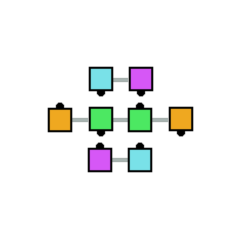|
Chain Reaction starts in a formation like this. Notice that one dancer in the center line is directly facing a dancer on the outside.

Those two dancers Pass Thru. The dancer from the center line meets the other outside dancer, and those dancers do a Hinge. Meanwhile, the dancers at the end of the center line walk forward 1/4 of the way around the outside of the set, to meet one of the dancers that did a Hinge.
As a result of these actions, there will be a center star of four dancers and two pairs of outside dancers. The dancers in the star move forward 1/4 (one position) in the star, while the outside pairs Trade.
At this point, one of the outside dancers will be meeting one of the dancers from the star. Those dancers take hands and Cast Off 3/4, to become the centers of new parallel lines. The other four dancers "move up" to become ends of the lines, in the same way as four dancers move up to become ends of lines in a Coordinate.

Of course all of these actions take place immediately following each other. The dancers don't stop at each position.
This isn't actually as complicated as it may sound, because each dancer isn't doing all of these things. You may find it helpful to review the action in this example from the perspective of the dancers in each of the four starting positions. You can use the animation to follow each starting position in turn.

- The dancer who starts on the outside, directly facing one of the dancers in the very center: passes thru with that dancer, without turning, becomes part of the star and moves forward one position in the star, meets a dancer with the other hand and does a 3/4 turn.
- The other dancer who starts on the outside, not facing somebody in the center: waits until a dancer comes out of the center, does a hinge with that person to become part of the star, moves forward one position in the star, and veers outward to become an end of the new line.
- The dancer who starts in the very center: passes thru with a dancer on the outside, does a hinge with the other outside person to meet somebody walking around the outside of the set, trades with that person, and then continues walking forward while turning to become the trailing end of a new line.
- The dancer who starts as the end of the center line: walks around the outside of the set, meets one of the dancers who has just done a hinge, trades with that person, and then turns 3/4 with one of the dancers from the star.
Note that when Chain Reaction is done from a right-handed 1/4 tag, the hinge will be by the left, the star will be right-handed and the trades will be right-handed, the cast off 3/4 at the end will be left-handed, and the resulting waves will be right-handed.
If Chain Reaction is done from a left-handed 1/4 tag, the initial pass thru is still done passing right shoulders, but everything else will be reversed. The hinge will be right-handed, the star and trades will be left-handed, the cast off 3/4 will be right-handed, and the resulting waves will be left-handed. It is especially important in this case for the dancer on the outside to wait and actually do the hinge with the person coming from the center -- if they aren't both very familiar with this case, and don't actually do the hinge with each other, there is a good chance that one or both of them will end up in the wrong position.
Another common problem that beginners have with Chain Reaction is the distance to move in the star. Each person only moves 1/4 (90 degrees). This is a very short distance. Until you become accustomed to the path, you may want to take this part very slowly and deliberately, to make sure you don't overshoot.